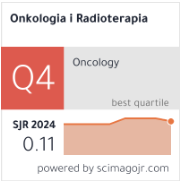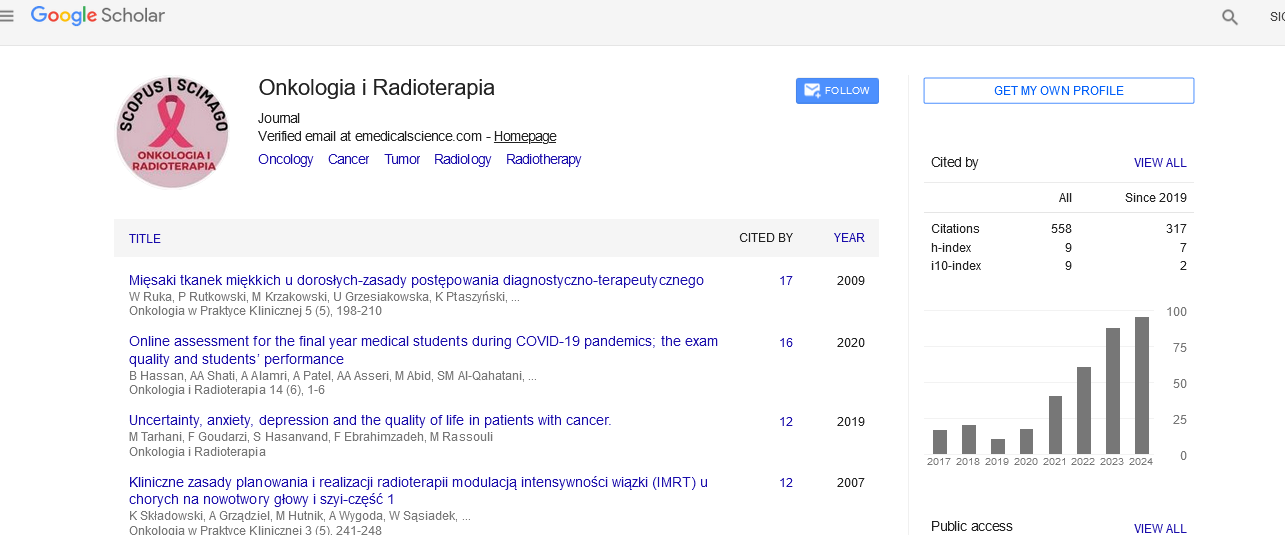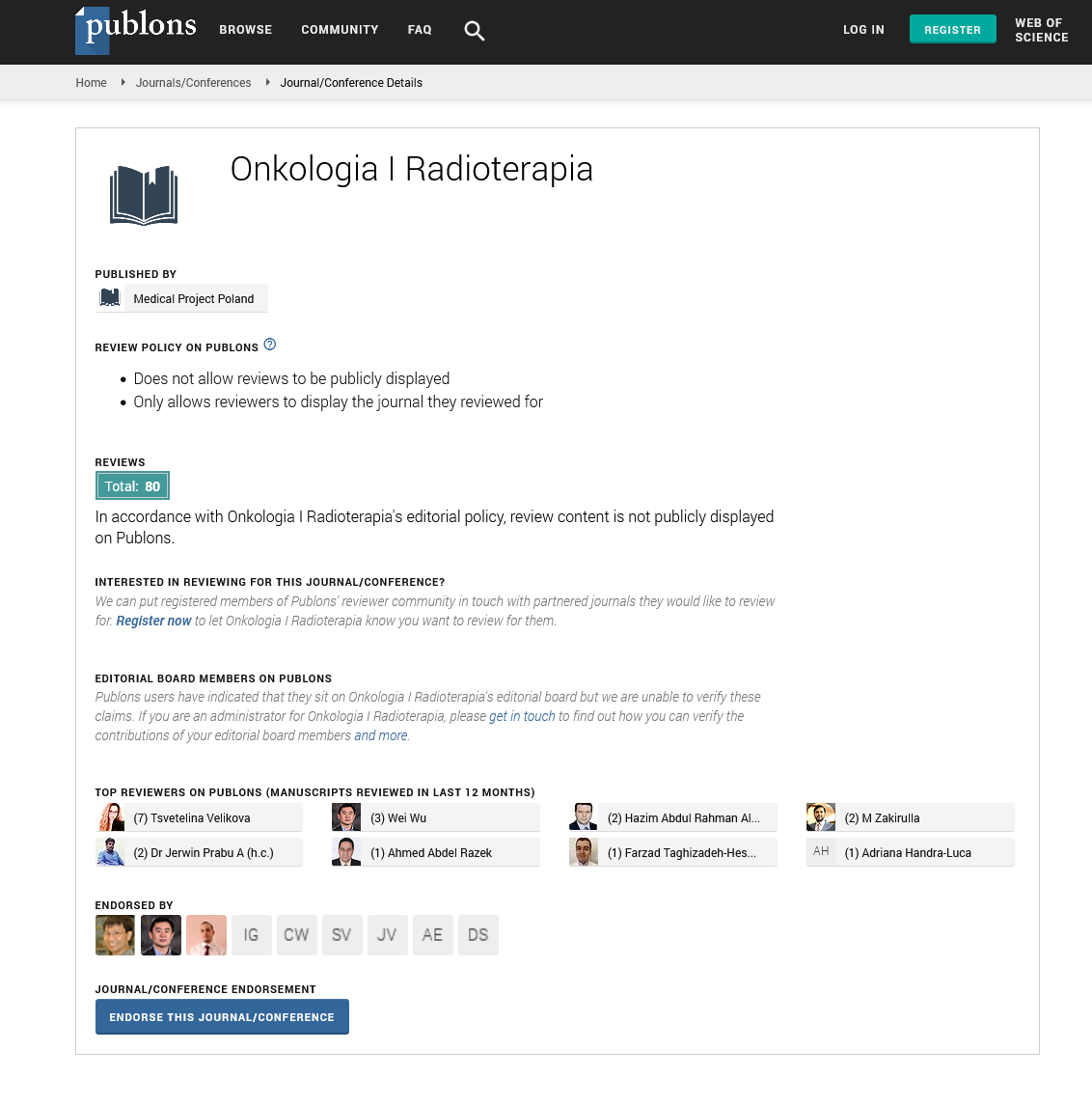Review Article - Onkologia i Radioterapia ( 2024) Volume 18, Issue 11
Pediatrics acute lymphoblastic leukemia
Karimeldin Mohamed Ali Salih*Karimeldin Mohamed Ali Salih, Department of Child Health, College of Medicine, University of Bisha, Bisha 61922, Saudi Arabia, Email: Ksachi@ub.edu.sa
Received: 16-Nov-2024, Manuscript No. OAR-24-152645; Accepted: 15-Nov-2024, Pre QC No. OAR-24-152645(PQ); Editor assigned: 19-Nov-2024, Pre QC No. OAR-24-152645(PQ); Reviewed: 05-Nov-2024, QC No. OAR-24-152645(Q); Revised: 12-Nov-2024, Manuscript No. OAR-24-152645(R); Published: 19-Nov-2024
Abstract
Introduction: Malignancies remain a leading global cause of death, with Acute Lymphoblastic Leukemia (ALL) being the most common pediatric leukemia, especially affecting boys aged 2 years-5 years. Characterized by uncontrolled T or B cell proliferation, ALL disrupts normal cell production, though its exact cause is unknown, but with some links to immunotherapy and genetic abnormalities.
Objectives for the review: Acute Lymphoblastic Leukemia (ALL) in children has a favorable prognosis; however, diagnosis is usually delayed due to symptoms overlapping with other common infections. To enhance pediatricians and health care workers to focus on the advancing diagnostic and treatment approaches for ALL and to develop high index suspicion for the diagnosis of ALL.
Methods: This review article employs a comprehensive approach to evaluate the diagnostic and treatment protocols for Acute Lymphoblastic Leukemia (ALL) in pediatric patients. The methodology includes a thorough literature review of existing guidelines and research studies, focusing on the workup processes such as complete blood counts, peripheral blood smears, bone marrow studies, flow cytometry, and genetic testing. The review also examines the classification of ALL, emphasizing the importance of accurate diagnosis through immunophenotyping and molecular genetic testing. Furthermore, the article discusses treatment strategies, including the implementation of antibiotic prophylaxis to mitigate infection-related complications during chemotherapy. Data from various studies and clinical guidelines are synthesized to provide recommendations for improving patient outcomes in ALL management. Google engine was used to search for ALL, using keywords such as acute, leukemia, lymphoblastic, malignancy, and childhood.
Results: Genetic mutation and abnormality interact with many other factors to culminate in acute lymphoblastic leukemia. The modified FAB and WHO classification remains the main classification for childhood leukemias. The symptoms and signs are the reflections of the bone marrow replacement by malignant cells and subsequent pancytopenia, invasion of other tissue, and infections. Complete blood picture, peripheral blood smear, bone marrow study, flow cytometry, and genetic studies. Despite the known protocols and their phases, antibiotic prophylaxis might improve the diagnosis in selected cases.
Conclusion: The favorable outcome from acute lymphoblastic leukemia might be improved further by adopting standard protocol for investigation, treatment, and prophylaxis.
Keywords
acute, lymphoblastic, leukemia, malignancy, childhood
Introduction
Acute Lymphoblastic Leukemia (ALL) is a common childhood malignancy that, when diagnosed early and treated adequately, can provide an optimistic prognosis. However, the initial clinical presentations of ALL can often mimic many other conditions and end in misleading diagnoses. Common symptoms such as tonsillitis, pharyngitis, gingival hypertrophy, and non-specific cervical lymphadenopathy may be misinterpreted as benign conditions, leading to a significant delay in the correct diagnosis and, ultimately, management. Physicians and all healthcare providers must maintain a high index of suspicion when encountering pediatric patients with these symptoms, particularly when they persist or are accompanied by other systemic signs like unexplained fatigue, pallor, weight loss, loss of appetite, or recurrent infections. Early recognition and intervention are paramount, as they significantly enhance the likelihood of a positive outcome for children diagnosed with ALL. Therefore, a thorough evaluation and consideration of hematological malignancies should be integral to the diagnostic process in such cases. Additionally, the advancement in genetics, diagnosis, classification, and treatment makes the dissemination of ALL knowledge a commitment for all health practitioners and other stakeholders. Finally, in developing countries, efforts, priorities, and budgets are usually directed at controlling communicable diseases, endemic diseases, HIV, and tuberculosis, which might distract decision-makers from malignancy plans.
Different authorities consider malignancy as the main cause of death worldwide; moreover, new cases and deaths are expected to account for 21.4 million and 13.2 million, respectively, by 2030, while in Africa, 681,000 new cases and 512,400 deaths were reported, respectively [1]. This figure can reflect the burden on the parents, their families, and health resources; therefore, intensive work is needed to make a diagnosis and subsequent treatment.
Acute Lymphoblastic Leukemia (ALL) is the most prevalent type of leukemia among children, accounting for 75%-80% of all cases of pediatric acute leukemia, with incidence estimated as 3 cases-4 cases per 100,000 in children less than 15 years of age [2]. Although no age is exempted for ALL, children between 2-5 are commonly affected with a tendency towards males [2]. The ALL is defined as the uncontrolled proliferation of the T or B cell that yields abnormal and immature cells that replace the normal cells and their progenitors in the bone marrow, spleen, liver, and lymph nodes [3, 4]. The etiology of ALL is still unknown, although some associations with immunotherapy and genetic abnormality are reported [5].
The ALL is one of the diseases involving multiple factors such as inheritance, environments, viruses, and radiation, which might interact to bring the pathogenesis [6]. Targeted therapies, like tyrosine kinase inhibitors for Philadelphia chromosome (Ph)- positive and Ph-like B-cell Acute Lymphoblastic Leukemia (ALL), are limited to a small group of pediatric patients. However, new molecular discoveries have spurred research into strategies that target disrupted cellular pathways. Immunotherapies have effectively treated advanced disease, including Chimeric Antigen Receptor (CAR) T-cell therapy and the bispecific engager blinatumomab. Genomic studies have improved the subclassification of acute lymphoblastic leukemia (ALL) and highlighted the interplay between inherited and somatic genetic changes. These findings are crucial for diagnosis, risk assessment, and developing novel targeted therapies [7]. Some genetics studies, for instance, Down syndrome, Fanconi anemia, Bloom syndrome, ataxia telangiectasia, and Nijmegen breakdown syndrome, showed a strong association with ALL in some cases [8]. Some pesticides, radiation, Epstein - Barr virus, and Human Immunodeficiency might also play a role in the etiology of ALL. However, the main cause is unknown [8].
OBJECTIVES
Acute Lymphoblastic Leukemia (ALL) among children is highly treatable, with an optimistic prognosis, and, like many other conditions condition in presentation, puts a big burden on health providers towards the management. Therefore, the objectives were to enhance the vigilance knowledge of the pediatricians and other healthcare providers towards ALL, to enhance continuous medical education, establish training programs to help clinicians with the subtle warning signs of ALL, and the importance of maintaining a high index of suspicion, especially in cases of persistent or unexplained symptoms. Additionally, it disseminates the genetic and pathogenesis of ALL.
Methodology
This review article adopts a comprehensive approach to evaluate the diagnostic and treatment protocols for Acute Lymphoblastic Leukemia (ALL) in pediatric patients. The methodology involves an in-depth analysis of the existing literature, including guidelines and research studies, focusing on diagnostic workup procedures such as Complete Blood Counts (CBC), peripheral blood smears, bone marrow analysis, flow cytometry, and genetic testing. The review highlights the significance of precise classification and diagnosis of ALL, emphasizing the role of immunophenotyping and molecular genetic testing to distinguish subtypes and tailor treatment plans effectively. Additionally, the article explores treatment strategies, including the potential benefits of antibiotic prophylaxis in reducing infection-related complications during chemotherapy, which remains a critical concern in pediatric ALL management. The findings synthesize data from multiple studies and clinical guidelines to formulate actionable recommendations to enhance patient outcomes. Google engine was used to search for ALL, using keywords such as acute, leukemia, lymphoblastic, malignancy, and childhood.
Results
Genetic mutations and abnormalities, in conjunction with various contributing factors, lead to the development of Acute Lymphoblastic Leukemia (ALL). The modified FrenchAmerican-British (FAB) and World Health Organization (WHO) classifications remain the standard frameworks for categorizing childhood leukemias. The clinical manifestations, including symptoms and signs, primarily arise from the replacement of normal bone marrow with malignant cells, resulting in pancytopenia, tissue infiltration, and susceptibility to infections.
Diagnostic evaluations, including Complete Blood Counts (CBC), peripheral blood smears, bone marrow examination, flow cytometry, and genetic analysis, are essential for accurate diagnosis and classification. While established treatment protocols are widely implemented, the use of antibiotic prophylaxis may enhance outcomes by reducing the risk of infections in specific cases.
Discussion
The discussion path through classification, symptoms and signs, workups and treatment.
Classification
The classification of Acute Lymphoblastic Leukemia (ALL) has evolved, progressed, and developed over time to communicate cellular features with genetic markers. The French-AmericanBritish (FAB) system was the first attempt to categorize ALL into L1, L2, and L3 subtypes based on cell size, cytoplasm, nucleoli, vacuolation, and basophilia [9]. Then, by 1997, the WHO made some revisions to this approach, introducing three main types: B lymphoblastic leukemia, T lymphoblastic leukemia, and Burkitt-cell leukemia. 15 years later, Burkitt-cell leukemia was removed from this classification and considered a separate entity [9].
Symptoms and signs
The symptoms and signs for ALL are usually related to the absence of adequately functioning red blood cells, platelets, and white blood cells, which ends with anemia, bleeding, and repeated infections [4, 10] Due to the damage of the DNA, the lymphoid tissues continue to grow without control, with an accumulation of platelets and white count in the lymphoid tissues, moreover, the spleen interacts with the abnormal white cells in an attempt to get rid of it [11, 12]. Early diagnosis, a properly adopted protocol for treatment, and regular meticulous follow-up will make a promising prognosis. In fact, the adoption of adherence to evidence-based protocols and guidelines may lead to a 90% cure rate [13]. The prognosis and the long-term survival rate depend on many factors, such as age, total WBC at the diagnosis, type, and character of the blast cells, and initial response to treatment [14]. Complications such as renal, sepsis, bleeding, encephalopathy, tumor lysis syndrome, secondary malignancy, growth retardation, and psychological issues were encountered [13, 15]. To make a proper diagnosis of ALL, a meticulous history should be obtained. All symptoms are related to the replacement of the bone marrow by the leukemic cell; therefore, symptoms are related to anemia, bleeding, repeated infection, testicular enlargement, encephalopathy, and bone pain [15, 16].
Common manifestations and clinical signs of ALL reflect bone and other tissues either replaced or invaded by malignant cells. The usual findings are anemias, bruises, lymphadenopathy, hepatosplenomegaly, papilledema, rigidity of the neck, cranial nerve palsy involvement, stridor, respiratory distress, and testicular enlargement [17].
Work Up for a child with acute lymphoblastic leukemia
A comprehensive diagnosis of ALL requires utilizing the history and clinical examination, morphologic assessment, immunophenotyping, karyotype analysis, and molecular genetic testing. Although there is consensus about the elements of the workup for ALL worldwide, there are few guidelines for complete workup than expected.
Accurate investigation is essential for ALL suspected cases, to decide on proper management. The basic known investigations such as cytomorphology, cytochemistry, flow cytometry immunophenotyping, immunohistochemical staining, and cytogenetic analysis. However, the importance of molecular diagnoses is overemphasized [18].
Investigations, such as immunophenotyping assays, Flow Cytometry Immunophenotyping (FCI), should be conducted to determine leukemia type, classification, and staging [19]. To meet the molecular and genetic changes in leukemic patients, molecular studies, Polymerase Chain Reaction (PCR), and reverse-transcriptase-based assays are to be considered [19]. The initial investigation includes a complete blood count and peripheral smear for blast checking, then depending on the number of blast cells, proceed to flow cytometry to determine the type of the leukemia cells, if it is T-lineage or B-lineage ALL. Moreover, an effort should be made to determine serum levels of uric acid, potassium, phosphorus, calcium, and LDH, which are measured to assess tumor lysis levels [20]. Additionally, bone marrow, cerebral-spinal fluid, radiography, and ECG studies are mandatory [20].
Treatment
Establishing the diagnosis and then treatment will depend on the guideline adopted by the institution concern.
Despite the high survival rates in Acute Lymphoblastic Leukemia (ALL), mortality continued, often due to complications arising from chemotherapy or febrile neutropenia. Therefore, continued innovation and the development of breakthrough therapeutic modalities are essential to improve patient outcomes and reduce mortality associated with these complications. Although the exciting guidelines help obtain survival above 90%, the application of the traditional treatment phase, such as induction, consolidation, and maintenance phase, has not changed [21]. Most of the mortality encountered during treatment of ALL is due to infection [22]. The infection secondary to febrile neutropenia plays a significant role in relapse, delay of response during the induction phase, and subsequent deaths [22]. Implementing antibiotic prophylaxis to treat Acute Lymphoblastic Leukemia (ALL) has emerged as a potential strategy for reducing mortality. However, its benefits must be carefully weighed against the risks, including the development of antibiotic-resistant organisms, the emergence of gram-negative bacteria, and the potential for opportunistic fungal infections. Balancing these risks to reduce fever, infection-related complications, and overall mortality remains critical [23].
Characteristics of the suggested antibiotic prophylaxis during the treatment of acute leukemia include being broad spectrum, less toxicity, long half-life, long bioavailability, ability to penetrate inside cells and tissues, bactericidal action, and interference with DNA synthesis [24]. Although antibiotic prophylaxis during the treatment of ALL is not well studied, however in some selected cases with prolonged febrile neutropenia, levofloxacin remains superior to ciprofloxacin due to its coverage on the viridian’s streptococci group [21].
Conclusion and Recommendation
The favorable outcome from acute lymphoblastic leukemia might be improved further by adopting standard protocol for investigation, treatment, and prophylaxis. To establish clear guidelines to guide healthcare providers in investigating and working on suspected cases of ALL, with full consideration for incorporating the ongoing research and advancement in the genetics of ALL etiology. To make a standard guideline for the work-up of ALL, clinical evaluation, hematological, biochemical, and imaging should be integrated with the new advances in genetics Finally reconsideration of the mortalities due to infection that occurred during treatment by antibiotic prophylaxis based on scientific ground.
Acknowledgment
The authors are thankful to the Deanship of Graduate Studies and Scientific Research at University of Bisha for supporting this work through the Fast-Track Research Support Program.
Conflict of Interest
No conflict of interest.
References
- Saeed ME, Cao J, Fadul B, Kadioglu O, Khalid HE, et al. A five-year survey of cancer prevalence in Sudan. Anticancer Res. 2016;36:279-286. [Crossref]
[Google Scholar] [PubMed]
- Sousa DW, Ferreira FV, Félix FH, Lopes MV. Acute lymphoblastic leukemia in children and adolescents: prognostic factors and analysis of survival. Rev Bras Hematol Hemoter. 2015;37:223-229.
[Crossref] [Google Scholar] [PubMed]
- Roberts KG. Genetics and prognosis of ALL in children vs. adults. Hematology Am Soc Hematol Educ Program. 2018;2018:137-145.
[Crossref] [Google Scholar] [PubMed]
- Jain T, Litzow MR. No free rides: management of toxicities of novel immunotherapies in ALL, including financial. Hematology Am Soc Hematol Educ Program. 2018;2018:25-34.
[Crossref] [Google Scholar] [PubMed]
- Margolin JF, Steuber CP, Poplack DG. Acute lymphoblastic leukemia. In: Pizzo PA, Poplack DG, editors. Principles and Practice of Pediatric Oncology. 15th ed. 2006.538-590.
- Ekpa QL, Akahara PC, Anderson AM, Adekoya OO, Ajayi OO, et al. A review of Acute Lymphocytic Leukemia (ALL) in the pediatric population: evaluating current trends and changes in guidelines in the past decade. Cureus. 2023;15.
[Crossref] [Google Scholar] [PubMed]
- Terwilliger T, Abdul-Hay MJ. Acute lymphoblastic leukemia: A comprehensive review and 2017 update. Blood Cancer J. 2017;7: 577.
[Crossref] [Google Scholar] [PubMed]
- Inaba H, Mullighan CG. Pediatric acute lymphoblastic leukemia. Haematologica. 2020;105:2524.
[Crossref] [Google Scholar] [PubMed]
- Jabbour E, O'Brien S, Konopleva M, Kantarjian H. New insights into the pathophysiology and therapy of adult acute lymphoblastic leukemia. Cancer. 2015;121:2517-2528.
[Crossref] [Google Scholar] [PubMed]
- Dinner S, Liedtke M. Antibody-based therapies in patients with acute lymphoblastic leukemia. Hematology Am Soc Hematol Educ Program. 2018;2018:9-15.
[Crossref] [Google Scholar] [PubMed]
- Ramos KN, Ramos IN, Zeng Y, Ramos KS. Genetics and epigenetics of pediatric leukemia in the era of precision medicine. F1000Res. 2018;7.
[Crossref] [Google Scholar] [PubMed]
- Valentin R, Grabow S, Davids MS. The rise of apoptosis: targeting apoptosis in hematologic malignancies. Blood. 2018;132:1248-1264.
[Crossref] [Google Scholar] [PubMed]
- Hunger SP, Lu X, Devidas M, Camitta BM, Gaynon PS, et al. Improved survival for children and adolescents with acute lymphoblastic leukemia between 1990 and 2005: A report from the Children's Oncology Group. J Clin Oncol. 2012;30:1663-1669.
[Crossref] [Google Scholar] [PubMed]
- Ribeiro KB, Buffler PA, Metayer C. Socioeconomic status and childhood acute lymphocytic leukemia incidence in São Paulo, Brazil. Int J Cancer. 2008;123:1907-1912.
[Crossref] [Google Scholar] [PubMed]
- Pui CH, Robison LL, Look AT. Acute lymphoblastic leukaemia. Lancet. 2008;371:1030-1043.
[Crossref] [Google Scholar] [PubMed]
- Muwakkit S, Al-Aridi C, Samra A, Saab R, Mahfouz RA, et al. Implementation of an intensive risk-stratified treatment protocol for children and adolescents with acute lymphoblastic leukemia in Lebanon. Am J Hematol. 2012;87:678-683.
[Crossref] [Google Scholar] [PubMed]
- Al Omari A, Hussein T, Albarrak K, Habib A, Sambas A, et al. Clinical characteristics and outcomes of acute lymphoblastic leukaemia in children treated at a single tertiary hospital in Riyadh, Saudi Arabia. J Health Spec. 2018;6:14.
- de Haas V, Ismaila N, Advani A, Arber DA, Dabney RS, et al. Initial diagnostic work-up of acute leukemia: ASCO clinical practice guideline endorsement of the College of American Pathologists and American Society of Hematology guideline. J Clin Oncol. 2019;37:239-253.
[Crossref] [Google Scholar] [PubMed]
- Arber DA, Borowitz MJ, Cessna M, Etzell J, Foucar K, et al. Initial diagnostic workup of acute leukemia: guideline from the College of American Pathologists and the American Society of Hematology. Arch Pathol Lab Med. 2017;141:1342-1393.
[Crossref] [Google Scholar] [PubMed]
- Kanwar VS, Satake N, Yoon JM. Pediatric acute lymphoblastic leukemia workup. Medscape. 2022.
- Dufrayer MC, Monteiro YM, Carlesse FA, Motta F, Daudt LE, et al. Antibiotic prophylaxis in acute childhood leukemia: What is known so far? Hematol Transfus Cell Ther. 2023;45:473-482.
- Prucker C, Attarbaschi A, Peters C, Dworzak MN, Pötschger U, et al. Induction death and treatment-related mortality in first remission of children with acute lymphoblastic leukemia: a population-based analysis of the Austrian Berlin-Frankfurt-Münster study group. Leukemia. 2009;23:1264- 1269.
[Crossref] [Google Scholar] [PubMed]
- Alexander S, Fisher BT, Gaur AH, Dvorak CC, Luna DV, et al. Effect of levofloxacin prophylaxis on bacteremia in children with acute leukemia or undergoing hematopoietic stem cell transplantation: a randomized clinical trial. JAMA. 2018;320:995-1004.
[Crossref] [Google Scholar] [PubMed]
- Bossu G, Di Sario R, Argentiero A, Esposito S. Antimicrobial prophylaxis and modifications of the gut microbiota in children with cancer. Antibiotics (Basel). 2021;10:152.
[Crossref] [Google Scholar] [PubMed]



